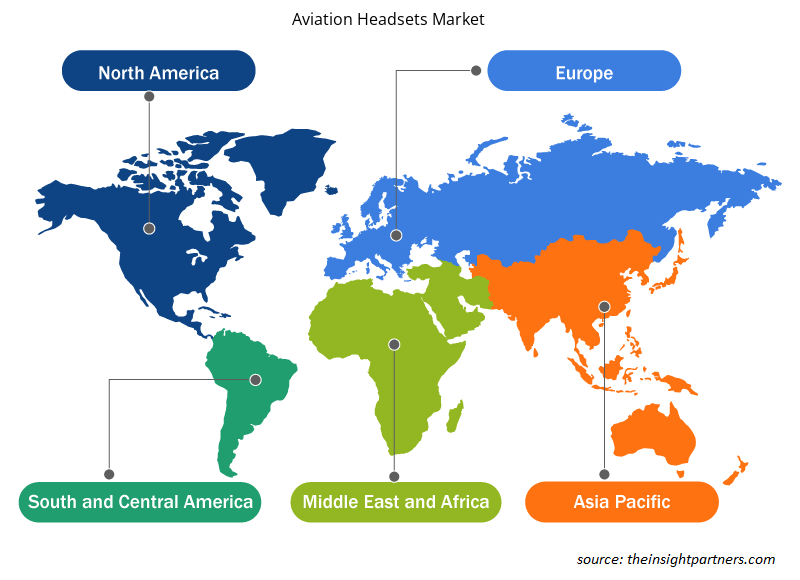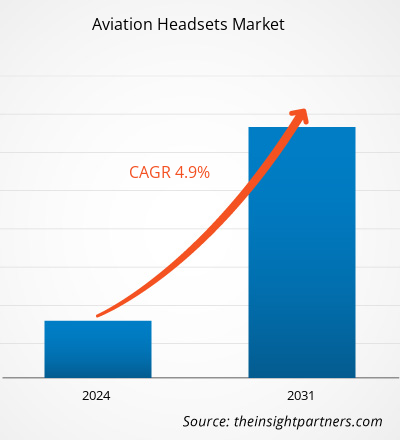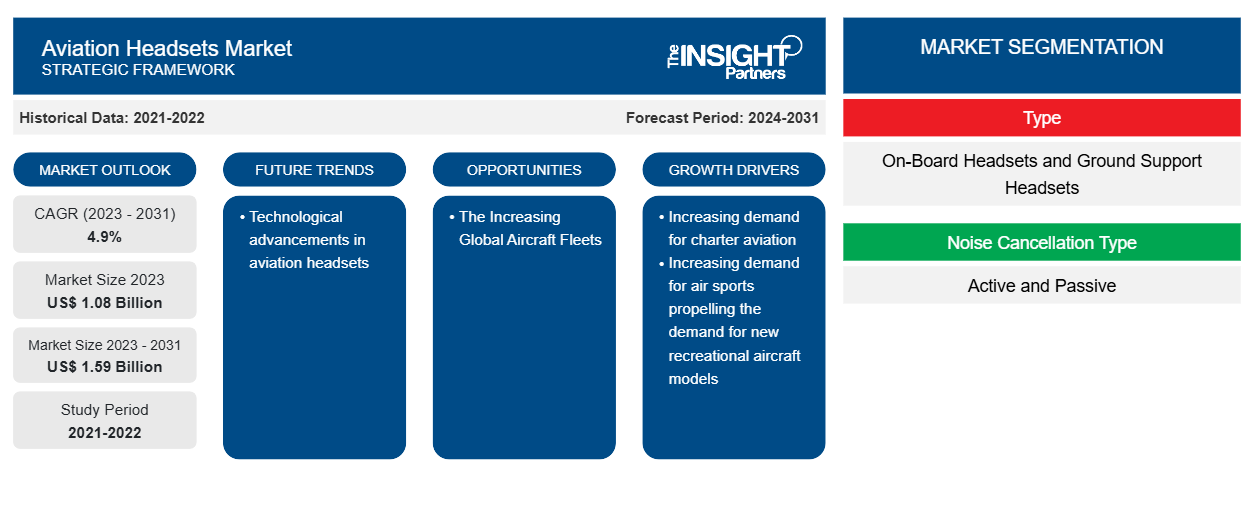Der Markt für Flug-Headsets soll von 1,08 Milliarden US-Dollar im Jahr 2023 auf 1,59 Milliarden US-Dollar im Jahr 2031 anwachsen. Der Markt wird zwischen 2023 und 2031 voraussichtlich eine durchschnittliche jährliche Wachstumsrate von 4,9 % verzeichnen. Der technologische Fortschritt bei Flug-Headsets dürfte ein wichtiger Trend auf dem Markt bleiben.
Marktanalyse für Luftfahrt-Headsets
Das Ökosystem des Marktes für Flugkopfhörer ist vielfältig und entwickelt sich ständig weiter. Seine Interessenvertreter sind Komponentenanbieter, Hersteller von Kopfhörern sowie Händler und Endverbraucher. Wichtige Akteure besetzen die verschiedenen Knotenpunkte des Marktökosystems. Die Komponentenanbieter liefern verschiedene Komponenten wie Halbleiterprodukte/Chipsätze, Mikrofone und Lautsprecherkomponenten an Hersteller von Flugkopfhörern, die diese dann zur Herstellung und Entwicklung der endgültigen Flugkopfhörerprodukte verwenden. Das Endprodukt wird dann über verschiedene Medien, beispielsweise den Direktvertrieb über Unternehmenshändler im gesamten Luftfahrtsektor, an die Endverbraucher vertrieben.
Marktübersicht für Luftfahrt-Headsets
Unternehmen wie Bosch Security & Safety Systems, Bose Corporation, David Clark Company, Lightspeed Aviation, GBH Headsets, Pilot Communications, Plantronics Inc., SEHT Limited und Sennheiser Electronic GmbH & Co. Kg gehören zu den führenden Herstellern auf dem Markt für Flug-Headsets. Diese Unternehmen sind in der Entwicklung, Herstellung und dem Verkauf einer breiten Palette von Flug-Headsets an Endverbraucher wie Fluggesellschaften, MRO-Unternehmen, Luftfahrt-OEMs und Verteidigungskräfte tätig.
Passen Sie diesen Bericht Ihren Anforderungen an
Sie erhalten kostenlos individuelle Anpassungen an jedem Bericht, einschließlich Teilen dieses Berichts oder einer Analyse auf Länderebene, eines Excel-Datenpakets sowie tolle Angebote und Rabatte für Start-ups und Universitäten.
-
Holen Sie sich die wichtigsten Markttrends aus diesem Bericht.Dieses KOSTENLOSE Beispiel umfasst eine Datenanalyse von Markttrends bis hin zu Schätzungen und Prognosen.
Treiber und Chancen auf dem Markt für Aviation Headsets
Steigende Nachfrage nach Luftsport treibt die Nachfrage nach neuen Freizeitflugzeugmodellen an
Die steigende Zahl der Auslieferungen von Leichtflugzeugen aufgrund des gestiegenen Bewusstseins für Luftsport bei jungen Menschen fördert die Einführung von Freizeitflugzeugmodellen der neuen Generation. So erzeugt beispielsweise die wachsende Flotte bestehender LSA (Leichtflugzeuge) weltweit eine Nachfrage nach neuen Piloten und Headset-Zubehör. Darüber hinaus wird die Nachfrage nach LSA hauptsächlich durch das steigende Interesse an Freizeitaktivitäten wie Fallschirmspringen angetrieben und ebnet neuen Akteuren den Weg zur Geschäftsgründung, während die bestehenden Akteure ihr Geschäft erweitern, indem sie eine neue Basis errichten und neue Flugzeuge kaufen. Daher fördert die wachsende Flotte von Leichtflugzeugen weltweit die globale Einführung von Flug-Headsets.
Die wachsenden globalen Flugzeugflotten
Der Sekundärforschung von The Insight Partners zufolge umfasste die weltweite Flotte kommerzieller Flugzeuge im Jahr 2022 rund 25.578 Flugzeuge und dürfte bis Ende 2024 auf rund 28.398 Flugzeuge und bis Ende 2034 auf rund 36.413 Flugzeuge anwachsen. Darüber hinaus dürften laut den Prognosen zweier der größten Flugzeughersteller, nämlich Boeing und Airbus, bis Ende 2042 mehr als 40.800 Flugzeuge ausgeliefert werden, was die Nachfrage nach neuen Piloten und Headsets in den kommenden Jahren weiter ankurbeln wird.
Segmentierungsanalyse des Marktberichts für Luftfahrt-Headsets
Wichtige Segmente, die zur Ableitung der Marktanalyse für Luftfahrt-Headsets beigetragen haben, sind Typ, Geräuschunterdrückungsart und Anwendung.
- Je nach Typ ist der Markt für Luftfahrt-Headsets in On-Board-Headsets und Ground-Support-Headsets unterteilt. Das Segment der On-Board-Headsets hatte im Jahr 2023 einen größeren Marktanteil.
- Basierend auf der Art der Geräuschunterdrückung ist der Markt für Flug-Headsets in aktive und passive unterteilt. Das aktive Segment hatte im Jahr 2023 einen größeren Marktanteil.
- Basierend auf der Anwendung ist der Markt für Luftfahrt-Headsets in Verkehrsflugzeuge, Militärflugzeuge und allgemeine Luftfahrt unterteilt. Das kommerzielle Segment hatte im Jahr 2023 einen größeren Marktanteil.
Marktanteilsanalyse für Luftfahrt-Headsets nach Geografie
Der geografische Umfang des Marktberichts für Luftfahrt-Headsets ist hauptsächlich in fünf Regionen unterteilt: Nordamerika, Europa, Asien-Pazifik, Naher Osten und Afrika sowie Südamerika.
Nordamerika dominierte den Markt im Jahr 2023, gefolgt von Europa und dem asiatisch-pazifischen Raum. Darüber hinaus dürfte der asiatisch-pazifische Raum in den kommenden Jahren auch die höchste durchschnittliche jährliche Wachstumsrate verzeichnen. Dies ist hauptsächlich auf die erwartete Auslieferung von mehr als 18.800 neuen Verkehrsflugzeugen in der gesamten Region in den nächsten zwei Jahrzehnten zurückzuführen. Darüber hinaus treibt die steigende Zahl der Flughäfen im asiatisch-pazifischen Raum auch den Einsatz von mehr Flugzeugen in der Region voran, was in den kommenden Jahren voraussichtlich neue Möglichkeiten für Marktanbieter schaffen wird.
Regionale Einblicke in den Markt für Luftfahrt-Headsets
Die regionalen Trends und Faktoren, die den Markt für Flug-Headsets im Prognosezeitraum beeinflussen, wurden von den Analysten von Insight Partners ausführlich erläutert. In diesem Abschnitt werden auch die Marktsegmente und die Geografie für Flug-Headsets in Nordamerika, Europa, im asiatisch-pazifischen Raum, im Nahen Osten und Afrika sowie in Süd- und Mittelamerika erörtert.

- Holen Sie sich die regionalen Daten für den Markt für Luftfahrt-Headsets
Umfang des Marktberichts zu Headsets für die Luftfahrt
| Berichtsattribut | Details |
|---|---|
| Marktgröße im Jahr 2023 | 1,08 Milliarden US-Dollar |
| Marktgröße bis 2031 | 1,59 Milliarden US-Dollar |
| Globale CAGR (2023 - 2031) | 4,9 % |
| Historische Daten | 2021-2022 |
| Prognosezeitraum | 2024–2031 |
| Abgedeckte Segmente |
Nach Typ
|
| Abgedeckte Regionen und Länder |
Nordamerika
|
| Marktführer und wichtige Unternehmensprofile |
|
Marktteilnehmerdichte: Der Einfluss auf die Geschäftsdynamik
Der Markt für Aviation Headsets wächst rasant, angetrieben durch die steigende Nachfrage der Endnutzer aufgrund von Faktoren wie sich entwickelnden Verbraucherpräferenzen, technologischen Fortschritten und einem größeren Bewusstsein für die Vorteile des Produkts. Mit steigender Nachfrage erweitern Unternehmen ihr Angebot, entwickeln Innovationen, um die Bedürfnisse der Verbraucher zu erfüllen, und nutzen neue Trends, was das Marktwachstum weiter ankurbelt.
Die Marktteilnehmerdichte bezieht sich auf die Verteilung der Firmen oder Unternehmen, die in einem bestimmten Markt oder einer bestimmten Branche tätig sind. Sie gibt an, wie viele Wettbewerber (Marktteilnehmer) in einem bestimmten Marktraum im Verhältnis zu seiner Größe oder seinem gesamten Marktwert präsent sind.
Die wichtigsten auf dem Markt für Luftfahrt-Headsets tätigen Unternehmen sind:
- Bosch Sicherheitssysteme
- Bose Corporation
- David Clark Unternehmen
- Faro Luftfahrt
- GBH Headsets
Haftungsausschluss : Die oben aufgeführten Unternehmen sind nicht in einer bestimmten Reihenfolge aufgeführt.

- Überblick über die wichtigsten Akteure auf dem Markt für Luftfahrt-Headsets
Marktnachrichten und aktuelle Entwicklungen zu Headsets für die Luftfahrt
Der Markt für Flug-Headsets wird durch die Erhebung qualitativer und quantitativer Daten nach Primär- und Sekundärforschung bewertet, die wichtige Unternehmensveröffentlichungen, Verbandsdaten und Datenbanken umfasst. Nachfolgend sind einige der Entwicklungen auf dem Markt für Flug-Headsets aufgeführt:
- Bose, der führende Anbieter von Premium-Headset-Technologie für die Luftfahrt, hat heute seine neueste Innovation vorgestellt: das neue A30 Aviation Headset. Das A30 wurde auf der SUN 'n FUN Aerospace Expo in Lakeland, Florida, vorgestellt und ist ein völlig neues Produkt, das Piloten die beste Kombination aus Komfort, Geräuschunterdrückung und Klangklarheit aller auf dem Markt erhältlichen Aviation Headsets bieten soll. (Quelle: Bose, Pressemitteilung, März 2023)
Lightspeed Aviation hat heute das Lightspeed Delta Zulu vorgestellt – das erste der nächsten Generation von ANR-Headsets. Dieses revolutionäre ANR-Headset für die Luftfahrt bietet eine Reihe neuer Funktionen und läutet eine neue Kategorie von Luftfahrtprodukten ein, die „Safety Wearables“ genannt werden. (Quelle: Lightspeed Aviation, Pressemitteilung, September 2022)
Marktbericht zu Headsets für die Luftfahrt – Umfang und Ergebnisse
Der Bericht „Marktgröße und Prognose für Luftfahrt-Headsets (2021–2031)“ bietet eine detaillierte Analyse des Marktes, die die folgenden Bereiche abdeckt:
- Marktgröße und Prognose für Aviation Headsets auf globaler, regionaler und Länderebene für alle wichtigen Marktsegmente, die im Rahmen des Berichts abgedeckt sind
- Markttrends für Aviation-Headsets sowie Marktdynamik wie Treiber, Einschränkungen und wichtige Chancen
- Detaillierte Porter-Fünf-Kräfte-Analyse
- Marktanalyse für Headsets für die Luftfahrt, die wichtige Markttrends, globale und regionale Rahmenbedingungen, wichtige Akteure, Vorschriften und aktuelle Marktentwicklungen umfasst
- Branchenlandschaft und Wettbewerbsanalyse, die die Marktkonzentration, Heatmap-Analyse, prominente Akteure und aktuelle Entwicklungen für den Markt für Luftfahrt-Headsets umfasst
- Detaillierte Firmenprofile
- Historische Analyse (2 Jahre), Basisjahr, Prognose (7 Jahre) mit CAGR
- PEST- und SWOT-Analyse
- Marktgröße Wert/Volumen – Global, Regional, Land
- Branchen- und Wettbewerbslandschaft
- Excel-Datensatz
Aktuelle Berichte
Erfahrungsberichte
Grund zum Kauf
- Fundierte Entscheidungsfindung
- Marktdynamik verstehen
- Wettbewerbsanalyse
- Kundeneinblicke
- Marktprognosen
- Risikominimierung
- Strategische Planung
- Investitionsbegründung
- Identifizierung neuer Märkte
- Verbesserung von Marketingstrategien
- Steigerung der Betriebseffizienz
- Anpassung an regulatorische Trends























 Kostenlose Probe anfordern für - Markt für Luftfahrt-Headsets
Kostenlose Probe anfordern für - Markt für Luftfahrt-Headsets